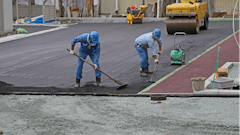
The 2024 Paving Top 50 moved in an unexpected direction this year. In our analysis of the data from 2022 and 2023, which saw a huge amount of growth to the tune of approximately $170 million in paving-only sales, from $742,226,477 to $913,190,892. We predicted that, while the market would not likely see an increase of that magnitude, it would still see some increase due to broader market factors like overall customer demand, inflation, and materials. However, that does not appear to be the case.
View Top 50 Contractors: Paving
For 2024, the Top 50 Paving Contractors generated $844,813,039 in paving only sales. This is a small contraction of $68,377,853, or, to put it another way, it shrank about 7.5% from the 2023 figure. While it isn't a big enough decrease to signal some sort of alarm, it is interesting, and worth dissecting. Obviously, our data is dependent, year-to-year, on the contractors who submit their data. We aren't necessarily seeing the same exact sample of information from one year to the next. However, if we take that into account, and presume generally similar conditions nationwide, the shrinkage still tells us something.
Possible Explanations
Firstly, it reveals that last year's number was possibly an even bigger aberration than we previously thought. A market increase of nearly 23%, nearly a quarter of the market size in 2022 to 2023, does seem preposterously large now, in retrospect. The 2024 figure, in some ways, is less of a market contraction, and more of a market normalization or correction. If we compare 2022 to 2024, what we get is slightly more realistic increase of $102,586,562, still a whopping 14% market boom.
Secondly, and this might be our strongest possible theory about the market's contraction, it might mean that 2024 was a year that saw far less NEW pavements laid, versus resurfacing. Something explored further below.
The third thing we might deduce from this data has to factor in the ongoing, and widely reported on, shortage of labor. How does that factor into sales? Hypothetically, it could mean that as contractors continue to struggle filling-out their paving crews with skilled and reliable workers, it has slightly impacted the amount of work that can be sold and completed in a given season. While there are, perhaps, some contractors not struggling with labor needs, that is not the industry trend as a whole. Most employers are in need of more workers, and more workers means more paving jobs, and, thus, higher sales figures. While there might be some contractors that are willing to over-commit themselves, stretched beyond the limit of what their staffing can allow them to accomplish at a high quality and customer satisfaction, the companies on the Top Contractor lists are not those.
Compared to the other industry segments in the Top Contractor survey, paving-only sales was still by far the highest earning, followed by pavement repair services at $285,633,742 ($315,056,146 in 2023) and sealcoating work at $152,812,613 ($186,110,524 in 2023) and then by striping sales at $89,944,735 ($129,954,003 in 2023). As you can see, at a glance, every area of sales has seen a similar deflation, with the most significant being striping segment. This might lend credence to the labor shortage theory, but we will discuss those segment in greater detail.
Total Sales for the Paving Top 50
The survey itself takes into account a much broader range of financial data than what we publicly report. We focus on the four main categories: paving, striping, pavement repair, and sealcoating. Some of that unpublished data does have an overall effect on this analysis as a whole, and in this case, the same trend from the paving-only figures runs parallel to the total sales, while still not being as steep a contraction. The Top 50 Paving contractors reported $1.614 billion in total sales, a small decline from 2023's massive $1.723 billion. A loss of approximately $109 million, or almost EXACTLY the same percentage fall of paving-only sales, 7.3%.
Those contractors who's primary business is in the realm of paving, while their revenue isn't exclusively paving, seem to have shouldered the losses directly in those operations, except for about .2% coming from other areas of their business, perhaps. A much more detailed analysis would be required to find these exact areas of loss, but it's clear that there may be a correlation.
The $1.614 billion from 2024 is still an overall increase from the 2022 total of $1.331 billion, but, interestingly, it's still a significant leap from both the 2021 total of $1.336 billion (based on a Top 75), and is still an edge above, what was a previous high before 2023, the 2020 total of $1.611 billion (Top 75). This lends more support for our earlier theories about why the market shrank this year, that it was a correction. If we look at these totals year-by-year for the past six, this is what we see:
- 2019 - $1.046 Billion
- 2020 - $1.611
- 2021 - $1.336
- 2022 - $1.331
- 2023 - $1.723
- 2024 - $1.614
New vs Old
While this is not determinant, our survey results do indicate a certain wave-like pattern of growth. Large increases followed by one or two years of lower but steady markets, followed by another large boost. Why might that be? In the absence of deeper economic statistics, it may signal that customer paving needs work along a cycle that mirrors that of typical asphalt-pavement lifespans, in conjunction with general new construction and community development.
There are years, sometime consecutive, that clients are seeking resurfacing work predominantly, and then there are years where the need for new pavements jumps. This would help explain why paving sales decreased, but profit margins and overall sales totals remained historically strong.
In order to better test this theory, next year, we plan to expand our survey to include a few new stats. If we determine how many paving jobs were new construction versus resurfacing jobs, we might start to understand the market trends better. Additionally, there are many paving contractors who also do their own site-prep, earthworks, and milling. We may, also, add survey questions in those areas to deepen our understanding of the market.
Profit Margins
As noted in the overview, we have shifted our profit margin ranges in an effort to normalize the distributions. Reviewing last year's results, 52% (26 contractors) of the Paving Top 50 reported profit margins greater than 15%. That means more than half were in the highest distributed range, making for an extremely top heavy graph, whereas the bottom range was less than 3% margins, and only represented only 4% (2 companies) of top contractors.
While this is informative on its own, telling us that those who rank in the Paving Top 50 are also those hitting the highest margins, it doesn't really tell us much more than that. While it may take a few years with the new model to start interpreting the data in a really thoughtful way, the new distribution is interesting right off-the-bat.
Unsurprisingly, the top margin earners are still over-represented, but the distribution is a little more even. For 2024
- Only 30% (15) of contractors ranked in the highest profit margin range of more than 20%
- 22% (11) ranked in the 16-20% range, which when added to those contractors ranking at +20%, is the same as last year, 26
- Another 30% (15) contractors in the 10-15% range, which is the only range that remains from 2023, relatively stable compared to the 14 reported last year
- 16% (8) contractors in the 6-9% range
- Only 2% (1) contractor at 5% or less
These results indicates the new ranges haven't negatively impacted the results, only displayed them in better detail. If you're paving profit margins are less than 10% then you have less than a 18% chance of ranking in the Paving Top 50. That's something worth considering when job costing and bidding on new work. Where are you currently sitting, and where are your goals?
Type of Jobs
- While every contractor in the Paving 50 did at least some parking lot work, at an average of 72%, there was one outlier that only derived 4% of its work from parking lots
- That same outlier did the remainder of their work (96%) in paving driveways, throwing off that curve as well, where 31 of the Paving 50 averaged 13% of its work from driveways
- Only 8 contractors completed work on highways at an average of 15% of their total work composition
- 35 contractors did residential streets or roadwork at an average of 22% of their total work composition
Customer Mix
- While every contractor did work in the commercial/industrial space, our favorite outlier only clocked 1% of their work there, where the average was 54%
- 40 contractors completed work for cities or municipalities at an average of 16% of their work composition
- 45 did work for multi-family residences at an average of 29% of their work composition
- 29 contractors completed work for single-family residence at an average of 14% of work composition, except, of course, for our outlying contractor who skewed the result slightly with a whopping 99% of their work in this sector
- 44 of the Paving Top 50 did at least some work as a subcontractor, deriving an average of 26% of their work from it
Fleet Replacement
Matching last year's 36 contractors who reported it would require more than $2 million to replace their current fleet of machines, it appears that it is another metric that should be changed for next year's survey. The continuous rise in machinery costs and availability means that the question currently doesn't provide much in the way of detailed information. Eight companies reported it would require between $1 - $2 million, four between $500,000 - $1 million, and one apiece for the ranges between $250K - $500K and less than $250K.


























